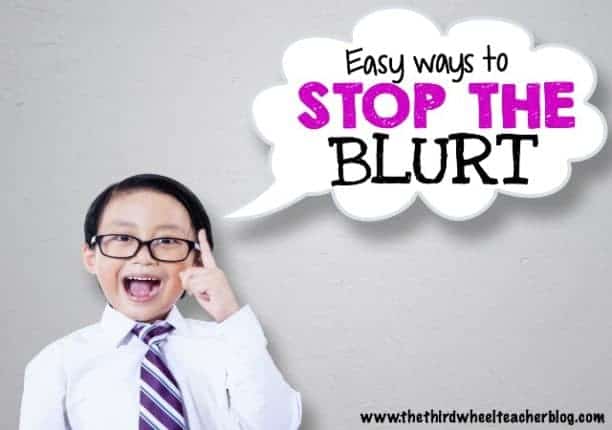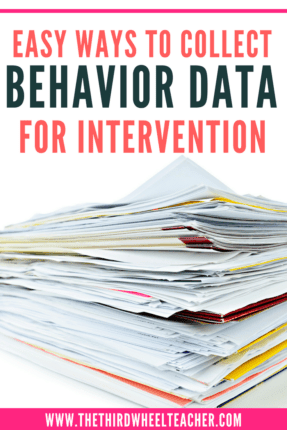3 Super Easy Interventions for Blurting Out in Class
Every year I get that one kiddo. The sweet-as-pie child that just can’t contain his excitement when they know the answer to a question I’ve posed…especially when the answer is not quite correct and ends up misleading her classmates. He blurts out his answer the instant the question has been completed, and he struggles when you ask him to wait his turn. This makes it challenging to give other students the wait time necessary to be successful. However, over time I’ve built a repertoire of interventions and strategies that have been helpful for students who blurt. Today I want to share the top three intervention strategies I use for students who call out in my classroom.

3 Low-Prep Interventions for Blurting Out in Class
1. Gradual Release Self-Monitoring Strategy:
As with all gradual release methods, the goal of this intervention for blurting out in class is to build the student’s self-awareness and ownership.
For this intervention, the student gets a laminated index card and a whiteboard marker on their desk. The goal is that they will make a tally on their card each time they blurt. The goal is to gradually decrease the number of times a student blurts by building their self-awareness of the issue. Initially, this may mean you have a signal to help the student notice when they’ve blurted and need to make a tally.
Gradually, you will release this responsibility to the student when you notice they are beginning to self-monitor. This may take several weeks…remember this bad habit has been practiced for longer than that and will take a while to break.
How to implement the intervention:
- Track how many times the student blurts over a day for 1-2 days before starting. This will give you baseline data to track if he is improving.
- Have a one-on-one conversation with the child and explain you’ve noticed that he often calls out or blurts answers in class. Tell him that you love that he is so excited to learn. However, taking a moment and giving other kids a chance to think about the answer is important, too.
- Introduce the index card and marker. Explain that he will make a tally every time he blurts to start noticing how often it happens.
- Introduce the term self-monitoring. This is an important skill for a learner because it helps us think about our thinking.
- Tell the student that you will check in with him after a set period. See below for more ideas on how to set this time. He will count his tally marks. Then the two of you will quickly discuss whether the number is increasing or decreasing.
- Depending on the severity of the problem, you will check in with the student to count their tally marks after a selected period.
You will want to check and count the tally marks after each hour for your students with a more severe case of blurts. For students with less significant blurting issues, morning and afternoon or the end of the day may work.
2. Stop-and-Jot:
Sometimes your students who blurt do this because they are afraid of forgetting their great idea. Blurting is incredibly functional in this situation. It allows the child to get the idea out before it is gone. However, you can fix this! This simple intervention only needs a small pad of post-it notes.
How to implement the intervention:
- Track how many times the student blurts over a day for 1-2 days before starting. This will give you baseline data to track if he is improving.
- Have a one-on-one conversation with the child and explain that you’ve noticed she yells out her answers. Ask her if she has noticed this and why she thinks it might be happening.
- Explain that you know she has many great ideas in her head. Tell the student you love it when she contributes to the conversation. However, sometimes, blurting can make it hard for classmates to learn. This recognizes the positive aspects and encourages her to participate in the intervention without making it seem like a punishment.
- Introduce the post-it pad. If you have several options, letting the student choose their color or shape is always a great way to build buy-in.
- Explain to the student that when they want to share their answer, they can write it on a post-it, fold it, and place it on the edge of their desk. You will come by, read the post-it and do an individual check-in while the other students are experiencing wait time.
Over time your goal (as the teacher) will be to check in less often…waiting until the student has 2-3 post-it notes before check-in. You will let the student know that if they raise their hand quietly, you will still call on them to share with the class. (Do this frequently at first to reinforce a quietly raised hand…and gradually pull it away as the child builds self-control.)
3. Three Tokens:
This is one of those interventions that is my go-to choice when I have a student who blurts but can control it. They may share irrelevant things or not think before speaking, but they know the situation. It is super easy, and requires very few resources. Plus, it is easy for me to track data. That is always a bonus.
How to implement this blurting intervention:
- For this intervention, all you need is three of something (tickets, math cubes, coins, etc.).
- Track how many times the student blurts over a day for 1-2 days before starting. This will give you baseline data to track if he is improving.
- Tell the student you are excited that they want to share. However, sometimes it can make it hard for others. Show them the three items. Explain every time they want to share first, they can trade an item for that opportunity. If they blurt, you will take one the same as if they asked to share.
- As you implement the intervention, remind the student you are taking one because they blurted or volunteered to go first. At the end of each period, track how many “tokens” the student still has.
- Over time, you will see a pattern about when the student is more prone to blurting or desiring to participate and share first. Adjust your pattern of calling on him to better match his patterns. You can also watch to determine if the intervention has effectively reduced talking out of turn.
- Early on, you might need to give the student three “tokens” for the morning and reset for the afternoon…or even for the hour, depending on the student and how often they blurt at the baseline.
- You might also need to exclude certain times – like morning sharing time – if it is a time when students are working to build classroom community, answer questions, and often talk without raising their hands.
The great part about this intervention is that it pushes your kids who already have self-awareness to consider and develop thoughtful answers. They think about whether they have a quality answer to share or just want a chance to talk.
I am Doing Interventions..but How Do I Document the Data?
Documenting can be pretty easy with all three strategies. Use a post-it note, calendar, or even a piece of paper to create a tally chart of how many times the student blurted during the different sections of the day.
This is super easy for the self-monitoring strategy because students track the data for you…all you have to do is write it down. Similarly, you can track the number of ‘tokens’ you take throughout the day.
The Stop-and-Jot is the most difficult to monitor of the interventions for blurting out in class because it will require more of your time.
However, putting a set of paper clips in your left pocket and moving one to the right each time the student blurts or doing the same thing with rubber bands can make it much easier to track without interrupting your lessons.
This way, you can record how many paper clips or rubber bands are on the right at the end of the period.
Don’t give up on interventions for blurting out in class too soon.
It can be challenging to feel like collecting data is a fluid part of your process. However, it is an important part of the process.
Collecting data will let you know if there is a specific time of day the problem occurs more. It will also let you monitor if the issue is improving.
This data will be critical if you feel this behavior is impeding academic progress for the student. You can also take it to an MTSS meeting if you need to take the child further in the RTI process.
What do you do for your students who blurt?






